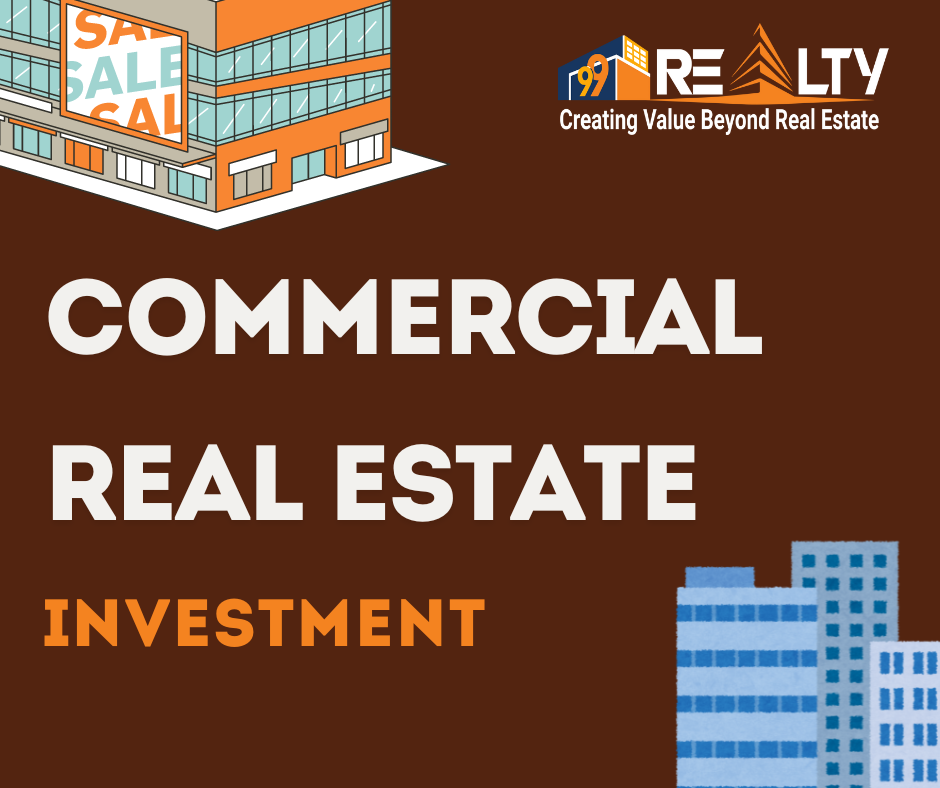India’s commercial real estate market is a burgeoning sector, anticipated to grow at a CAGR of 13% between 2022 and 2027. By 2030, the Indian real estate market is projected to reach $1 billion, with commercial real estate being a significant contributor. As a favored investment choice among astute investors, commercial property offers high returns on investment (ROI), capital appreciation, and passive income opportunities. In this comprehensive guide, we delve into the essentials of commercial property investment in India.
Understanding Commercial Property Investment
Commercial properties are those utilized for business or non-residential purposes, generating income through leasing or selling. Investing in such properties with the aim of producing cash flow is termed as commercial investment. Various avenues exist for investing in commercial real estate, each offering distinct advantages.
Types of Commercial Property Investments
As a commercial real estate (CRE) investor, you have a wide array of investment options:
- Office Buildings
- Retail Buildings
- Industrial Buildings
- Multifamily Buildings
- Hospitality Buildings
- Mixed-Use Buildings
- Medical Buildings
For a detailed exploration of these types, refer to our blog on Commercial Real Estate Meaning & Basics.
Ways to Invest in Commercial Real Estate in India
- Direct Investment: Purchase commercial property individually or as part of a group and manage it.
- Real Estate Investment Trusts (REITs): Buy shares in companies owning commercial properties, trade on stock exchanges, and earn income via dividends.
- Real Estate Crowdfunding: Pool money with other investors to invest in property or portfolios with smaller capital amounts.
- Private Equity Funds: Pool capital from high-net-worth individuals or institutional investors for larger commercial real estate projects, typically requiring a minimum investment.
Why Choose Commercial Investment?
- Inflation Hedge: Commercial properties are resilient to inflation, benefiting from rising property prices, rent hikes, and value appreciation.
- Regular Returns: Pre-leased commercial properties generate consistent rental income due to long-term leases of 5-15 years, ensuring stability.
- Tangible Asset: Unlike volatile stocks and bonds, commercial properties offer steady appreciation and are less affected by market fluctuations.
Advantages and Disadvantages of Investing in CRE
Pros
- High Rental Income: Commercial properties in India yield rental income between 8-11%, significantly higher than residential properties.
- Long-term Commitments: Leases often span 10-20 years with annual rental appreciation, providing consistent returns.
- Professional Deals: Corporate tenants, often with professional track records, ensure hassle-free rent payments and property management.
- No Furnishing Costs: Corporate tenants typically furnish properties according to their branding needs, saving investors furnishing expenses.
- Appreciation Value: CRE often offers superior appreciation over time, especially premium properties through fractional ownership or REITs.
- Market Fluctuation Immunity: CRE investments are not influenced by stock or bond market changes.
- Tangible Asset: Real estate offers a physical and tangible asset that investors can inspect and evaluate.
Cons
- High Ticket Size: CRE investments often require significant capital, though fractional ownership now allows investments starting from Rs. 30 Lacs.
- Complex Asset Management: Managing corporate tenants and commercial assets requires professional expertise.
- Difficult Entry: Extensive research and navigating legal complexities can be challenging for novice investors.
- Property Selection: Identifying the right property and location requires due diligence and market knowledge.
Commercial vs. Residential Property Investment
| Category | Commercial Property | Residential Property |
|---|---|---|
| Buying Process | Lengthy and involves many formalities | Comparatively easier |
| Period of Lease | Long-term leases (3-9 years or more) | Shorter leases (6 months or more) |
| Contract for Rent | In-depth and complex | Simpler contracts |
| Rental Yield | 8-11% | 1.5-3.5% |
| Income Stability | Stable due to long lease periods | Less stable due to frequent tenant changes |
| Loan Process | Loans available to individuals or businesses | Loans available only to individuals |
| Leasing Process | Equal involvement of tenant and owner | Tenant-friendly legislation |
Evaluating the Profitability of Commercial Properties
Investors seek properties that promise high returns. Here are key parameters to evaluate before investing:
- Prime Locations: Location determines property price, rent, ROI, IRR, and appreciation rates. Invest in hotspots for higher returns.
- Tenant Quality and Occupancy Rate: Higher occupancy and quality tenants (e.g., MNCs) ensure regular rental income.
- Amenities and Facilities: Properties with top amenities attract better tenants and higher rents. Proximity to transportation enhances desirability.
- Triple Net Lease: Tenants cover property insurance, tax, and maintenance, reducing owner expenses and providing steady income.
- Lock-in Period: Long-term lock-in periods ensure stable rental income. Early exits by tenants incur penalties.
- Rent Escalation: Regular rent increases (e.g., 5% annually) enhance rental yields.
- Higher NOI Rates: A high Net Operating Income (NOI) indicates better profitability. NOI is calculated by subtracting operating expenses from revenue.
- Internal Rate of Return (IRR): A higher IRR (e.g., 22%) suggests better investment returns.
Despite certain advantages in the buying process and loan accessibility for residential properties, commercial real estate offers superior rental yields, income stability, and lease terms, making it a preferred investment option.
Subscribe to get updates on our latest posts and market trends.






Join The Discussion